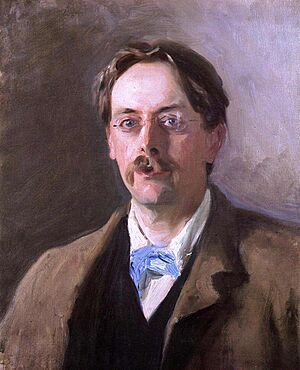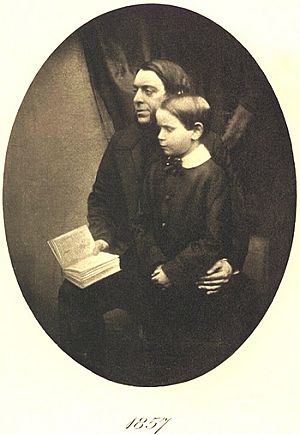Edmund Gosse facts for kids

Sir Edmund William Gosse (born September 21, 1849 – died May 16, 1928) was an English poet, writer, and critic. He grew up in a very strict religious group called the Plymouth Brethren. However, he later decided to leave that faith. His book Father and Son tells the story of his childhood and is seen as one of the first books to explore a person's life and feelings in a deep way.
Edmund Gosse became good friends with the sculptor Hamo Thornycroft. This friendship led him to write a lot about Victorian sculpture. He also helped introduce the plays of Henrik Ibsen from Norway to English audiences. He supported the careers of famous writers like W. B. Yeats and James Joyce. He also taught English literature at Cambridge University.
Contents
Growing Up
Edmund Gosse was the son of Philip Henry Gosse, a naturalist (someone who studies nature), and Emily Bowes, an illustrator and poet. Both of his parents were very religious and belonged to the Plymouth Brethren.
His early childhood was happy. They spent summers in Devon, where his father was developing ideas for the popular marine aquarium. Sadly, his mother passed away from breast cancer when he was eight years old. After this, his life with his father became more difficult because his father wanted him to follow the same strict religious path.
Edmund was sent to a boarding school, where he started to develop his own love for literature. In 1860, his father married Eliza Brightwen, a religious Quaker. Edmund later wrote about his childhood in Father and Son. This book explores his difficult relationship with his father and his journey to independence. When he was 18, working at the British Museum in London, he made a big decision to break away from his father's strict influence.
His Career and Works

Edmund Gosse began his career in 1867 as an assistant librarian at the British Museum. He got this job with help from Charles Kingsley. An early book of poetry he wrote with a friend, John Arthur Blaikie, helped him meet the Pre-Raphaelite Brotherhood, a group of artists and writers.
Between 1872 and 1874, he traveled to Denmark and Norway. There, he met famous writers like Hans Christian Andersen. These trips led him to write successful reviews of plays by Henrik Ibsen and Bjørnstjerne Bjørnson for the Cornhill Magazine. He soon became known for reviewing Scandinavian literature.
He became friends with many important writers of his time, including Alfred, Lord Tennyson, Robert Browning, Algernon Charles Swinburne, Thomas Hardy, and Henry James.
In 1873, he published his first poetry book by himself, On Viol and Flute. In 1875, he became a translator at the Board of Trade. This job gave him enough time to write and start a family.
From 1884 to 1890, Gosse taught English literature at Trinity College, Cambridge. Even though he didn't have a university degree, Cambridge University gave him an honorary Master of Arts degree in 1886. He also gave successful lectures in America in 1884.
In the 1880s, he became an important art critic, especially for sculpture. He was inspired by his close friendship with the sculptor Hamo Thornycroft. In 1894, Gosse wrote the first history of the new wave of late-Victorian sculpture, calling it the New Sculpture.
In 1904, he became the librarian of the House of Lords Library, a very important position, until he retired in 1914. He wrote for the Sunday Times and was an expert on several classic English writers. He is also credited with introducing Henrik Ibsen's plays to the British public. Gosse worked with William Archer to translate plays like Hedda Gabler and The Master Builder.
Gosse also helped two struggling Irish writers, W. B. Yeats in 1910 and James Joyce in 1915, get financial support. This allowed both writers to continue their writing careers.
His most famous book is Father and Son, published in 1907. It tells the story of his difficult relationship with his father. This book was even made into a television show.
Another of his works is The Autumn Garden, a collection of poems published in 1908. He was also the literary editor for the 1911 edition of the Encyclopædia Britannica.
Family Life
Edmund Gosse married Ellen Epps (1850–1929) in August 1875. Ellen was a painter. They were married for over 53 years and had three children:
- Emily Teresa ("Tessa") (1877-1951)
- Philip Henry George (1879–1959), who became a doctor and wrote a book called The Pirates' Who's Who.
- Laura Sylvia (1881-1968), who became a well-known painter.
In 1907, Ellen inherited a large amount of money from her uncle, which helped the family.
Awards and Recognition
Edmund Gosse received several honors for his work. He was named a Companion of the Order of the Bath (CB) in 1912. He was also made a knight in 1925, which means he could use the title "Sir."
Published Works
Poetry Books
- Madrigals, Songs, and Sonnets (1870), with John Arthur Blaikie
- On Viol and Flute (1873)
- King Erik (1876)
- New Poems (1879)
- Firdausi in Exile (1885)
- In Russet and Silver (1894)
- Collected Poems (1896)
- Hypolympia, or the Gods on the Island (1901)
- The Autumn Garden (1908)
Books of Criticism
- English Odes (1881)
- Seventeenth Century Studies (1883)
- Life of Thomas Gray (1884)
- Life of William Congreve (1888)
- A History of Eighteenth Century Literature (1889)
- Gossip in a Library (1892)
- The Jacobean Poets (1894)
- Critical Kit-kats (1896)
- A Short History of Modern English Literature (1897)
- Life and Letters of Dr John Donne, Dean of St Paul's (1899)
- Illustrated Record of English Literature, with Richard Garnett (1903–1904)
- Jeremy Taylor (1903)
- Life of Sir Thomas Browne (1905)
- French Profiles (1905)
- Portraits and Studies (1912)
- Collected Essays (1912)
- Three French Moralists (1918)
- Malherbe and the Classical Reaction in the Seventeenth Century (1920)
- More Books on the Table (1923)
Biographies (Life Stories)
- Gray (1882)
- The Life of Philip Henry Gosse, F.R.S. (1890)
- Father and Son (1907)
- The Life of Algernon Charles Swinburne (1917)
Other Works
- The Secret of Narcisse. A Romance (1892)
- Two Visits to Denmark, 1872, 1874 (1911)
- Inter Arma (1916)
- Some Diversions of a Man of Letters (1919)
See also
 In Spanish: Edmund Gosse para niños
In Spanish: Edmund Gosse para niños

